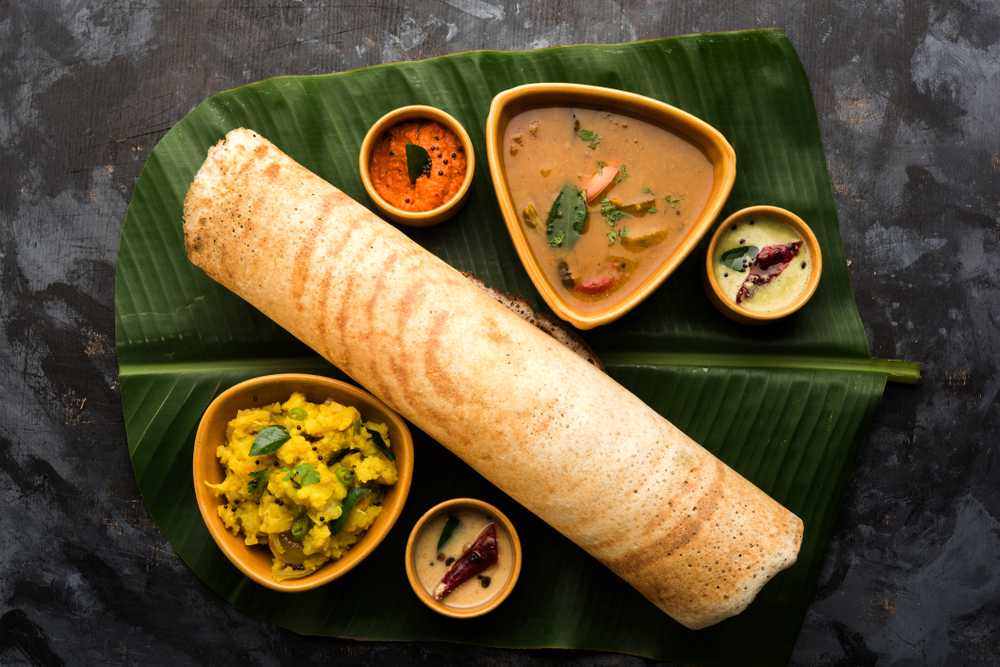Dosa is a super crispy, thin pancake from South India. It's made from a fermented batter of rice and urad dal (black lentils). This dish is very popular and comes with different fillings or tasty dips like chutney or sambar (a lentil-based stew). Making dosa might seem a bit tricky at first because of the fermentation, but once you get the hang of it, it's actually quite fun.

It's perfect for breakfast, lunch, or even dinner and is loved for its delicious taste and versatility. Plus, it's a great way to dive into South Indian cuisine right at home.
Table of Contents
Why This Recipe Works
This dosa recipe is great because it sticks to the basics, making it perfect for beginners and dosa lovers alike. The combination of rice and urad dal, when fermented properly, gives the dosa its characteristic sour flavor and perfect texture that's crispy on the edges and soft in the middle. This recipe simplifies the traditional process without cutting corners on taste or authenticity. It's designed to work well in modern kitchens, using tools you already have.
Moreover, the flexibility of this recipe is another reason to give it a try. Once you've mastered the basic dosa, you can experiment with fillings like the classic masala (spiced potatoes) or innovate with something completely your own. This recipe is forgiving and flexible, making it easy to adapt to your taste preferences and the ingredients you have on hand. It's a fantastic way to introduce diverse and nutritious meals into your diet, leveraging the health benefits of fermented foods, and all without compromising on deliciousness.

Ingredients
Rice: The base of the dosa batter, usually a variety of long-grain white rice. Substitute: brown rice for a healthier option, though it alters the texture.
Urad Dal (Black Lentils): Adds fluffiness and crispness to the dosa. Substitute: split urad dal without skin if whole urad dal is not available.
Fenugreek Seeds: Improves the fermentation process and adds a subtle flavor. Substitute: a pinch of sugar to aid fermentation if unavailable.
Salt: Enhances the flavor of the dosa batter.
Water: Used to grind the rice and lentils into a batter. The consistency of the water can greatly affect the batter's texture.
Tips
- Soak rice and urad dal separately for at least 6 hours or overnight to ensure proper fermentation.
- Grind the batter to a smooth consistency, using a wet grinder for best results.
- Ferment the batter in a warm place until it doubles in volume for a tangy flavor.
- Use a non-stick or cast-iron skillet to get crispy edges and a soft center.
- Control the temperature of the skillet between dosas to avoid burning.

How to Serve
Dosa is a versatile South Indian crepe that can be served in various ways, making it suitable for any meal of the day. Traditionally, it is accompanied by a range of chutneys and sambar, a lentil-based vegetable stew.
- Masala Dosa: Fill the dosa with a spiced potato filling for a hearty meal.
- Cheese Dosa: Sprinkle cheese over the dosa while it cooks for a kid-friendly twist.
- Dosa with Coconut Chutney: A classic combination where the creamy coconut chutney complements the crisp dosa.
Similar Recipes

Dosa
Ingredients
- 1 cup rice
- ½ cup urad dal black lentils
- 1 teaspoon fenugreek seeds
- Salt to taste
- Water as needed for grinding
- Oil for cooking
Instructions
- Soak the rice, urad dal, and fenugreek seeds in separate bowls in plenty of water for at least 6 hours or overnight.
- Drain the water from the rice and dal. Grind the urad dal, rice, and fenugreek seeds with fresh water to make a smooth batter. Mix in the salt. The consistency should be slightly thick.
- Cover the batter and let it ferment in a warm place for 8-10 hours or until it doubles in size.
- Once fermented, gently stir the batter. If it's too thick, adjust the consistency by adding a little water.
- Heat a non-stick or cast-iron skillet over medium heat. Lightly oil the surface.
- Pour a ladleful of batter onto the skillet, spreading it into a thin circle.
- Drizzle a few drops of oil around the edges of the dosa and cook until the bottom is golden brown and crispy.
- Fold the dosa and remove it from the skillet. Serve hot.
- Repeat with the remaining batter, adjusting the skillet's heat as needed to prevent burning.
Nutrition
Notes
• Grind the batter to a smooth consistency, using a wet grinder for best results.
• Ferment the batter in a warm place until it doubles in volume for a tangy flavor.
• Use a non-stick or cast-iron skillet to get crispy edges and a soft center.
• Control the temperature of the skillet between dosas to avoid burning.